Velocity model tie to wells, Thomsen Delta parameter
![]()
![]()
The Delta Thomsen parameter (Δ) is a key anisotropy coefficient used in seismic velocity modeling to describe anisotropic effects in a transversely isotropic medium (VTI). This parameter accounts for variations in seismic wave propagation due to layered geological structures, where vertical and horizontal velocities differ.
In this module, Δ is derived from the isotropic velocity model tied to well data, enabling a more accurate estimation of subsurface velocity variations. The computed Δ cube is later utilized in the Time Table Calculation module for improved depth conversion and seismic imaging.
Calculation Process in the Module
The module estimates Δ using the following workflow:
1.Input Data & Preprocessing
oAn isotropic velocity model is generated by tying seismic velocities to well log data.
oWells, seismic stacks, and velocity overlays with input and corrected horizons are displayed in interactive windows.
oThe module allows selection of different methods for well surface creation, ensuring an optimal starting point for calculation.
2.Delta Thomsen (Δ) Calculation
oΔ is computed by analyzing the difference between interval vertical velocity (Vint-VTI) and the reference isotropic velocity model.
oThe result is a Delta Thomsen cube, which represents variations in anisotropy throughout the subsurface.
oThis cube is essential for depth conversion, seismic migration, and further anisotropic corrections.
3.Output Products
oVertical Interval Velocity Cube – Represents the vertical velocity variations used for depth modeling.
oDelta Thomsen Cube – Provides anisotropy corrections to enhance seismic imaging accuracy.


![]()
![]()
Init velocities - first step in this module is pressing init velocities button for rendering: Location map and Vertical sections.
Import horizon - load horizons for tie. Domain is TIME ms! Use separated ASCII files for each horizon and load them individually. This horizon will be automatically interpolated in converted into the depth domain by using input isotropic velocity. File format is ASCII.hor with the following columns (tab-delimited):
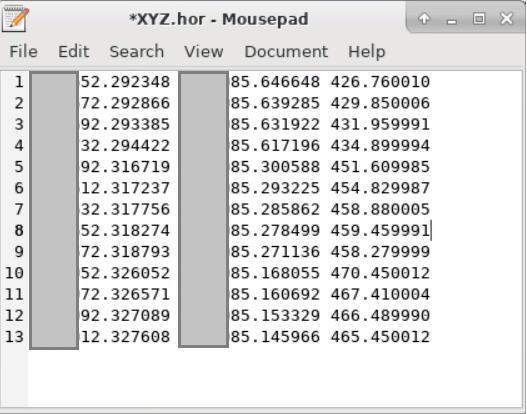
Important! Before the import, define its parameters as well, for example datum plane:

Import well markers V2 - load well tops for tie. Use one single ASCII file for all wells. Well tops in depth m, TVDSS. Pay attention! that module understand the datum plane, because of input velocity file: it reads trace headers RECEIVER_DATUM and SOURCE_DATUM, they are constant values, because this datum was defined during velocity conversion Vrms to Vint. Therefore, if this datum for headers is not 0, module will add datum plane value to well tops (it is for correct tie process). File format is ASCII.marks2 with the following columns (tab-delimited, 1-st row is names of columns, last column must be filled with something like -999):

Clear horizons - remove all horizons form the module.
Rebuild time maps - rebuild time maps in case you changed interpolation parameters for time horizons.
Create depth maps input V - build a horizon map of the input isotropic velocity.
Create depth maps output V - build a horizon map of the output vertical velocity.
Create well's maps - build a horizon map for tie process by using well tops in case you would like to option [Well tie options->Tie type->Strict by wells]. Check this layer in Location map vista after calculation.
Create diff maps - build a difference map between input and output (well-tied) horizons. Check this layer in Location map vista after calculation.
Fix maps according to sorting - use this option in case you would like to import horizons again. When new horizon was imported press fix maps button. All horizons in the module will be sorted by the depth values accordingly.
![]()
![]()
Input gathers - input isotropic velocity (loaded as seismic cube to the workflow).
Input time horizons - input time horizons.
![]()
![]()
V0 <m/s> - replacement velocity in m/s.
Type of creation - where are two types of creation vertical velocity and delta: 1 - smooth and gradient vertical model; 2 - layer vertical model.
Show cube vistas(for 3d) - create a 3D cube for visualization (seismic, velocity, delta, horizons).
Map interpolation:
Interpolation type - algorithms for map interpolation: Kriging, ABOS.
Kriging covariance - only for Kriging option: Spherical, Gaussian, Exponential.
Kriging range <meter> - only for Kriging option, is a maximum range for getting near point.
Kriging max points - only for Kriging option, is a maximum points for the interpolation.
Kriging sill - is the total variance contribution, or the maximum variability between pairs of points.
Interpolation step X <meter> - step in meters for the interpolation along X axes.
Interpolation step Y <meter> - step in meters for the interpolation along Y axes.
Use wells for boundaries - limit the map bounds by wells.
Use import horizons points for boundaries - limit the map bounds by input horizons.
Well tie options:
Marker distance <meter> - distance for well visualization on the current seismic/velocity stack section. so you can get bigger radius for searching wells around the inline/crossline. Used just for visualization.
Add bottom layer - add bottom layer to the model.
Number of iterations - iteration for tie process. Theoretically, bigger value, more accurate velocity model will be tied to wells.
Minimum velocity <m/s> - minimum velocity in m/s for the output velocity model.
Maximum velocity <m/s> - maximum velocity in m/s for the output velocity model.
Gradient type - there two gradients types for the output velocity model: smooth, simple.
Maximum distance to voronoi interpolation <meter> - distance/radius/area around wells for interpolation.
Maximum extrapolation distance <meter> - distance/radius/area around wells for extrapolation.
Extrapolate deepest layer coeef - explanation...
Allow regression extrapolation - explanation...
Tie type - Strict by wells, Emulate wells, Depth well's maps.
Step type - Grid, Trace.
Emulation step IL - step inline for emulation.
Emulation step XL - step crossline for emulation.
Resample options:
Resample - enable re sample option for velocity model.
Delta z after resample <meter> - depth interval in meters.
Depth maps smooth:
Step X <meter> - smoothing step along X direction.
Step Y <meter> - smoothing step along Y direction.
Smooth depth maps in - enable map smoothing of input horizons in depth.
Smooth depth maps out - enable map smoothing of output horizons in depth.
Smooth depth maps wells - enable map smoothing of wells horizons in depth.
Import horizons from ASCII params:
Location - datum plane for input horizons: Datum is constant value, Topography.
Datum <meter> - value for constant datum plane.
Scalar - explanation...
Add constant shift time <ms> - an additional time shift for input horizons (ms).
Add constant shift depth <meter> - an additional depth shift for input horizons (m).
Fit time horizon to new geometry - explanation...
Trace step to fit - explanation...
Import marker options:
Coordinate scalar - coefficient for coordinates X, Y.
Markers type - MD (measured depth) or TVDSS (true vertical depth). Use TVDSS.
Build maps on loading markers - enable option for well's map creation on loading.
Markers map type - group of methods for well's map creation: Simple, Trend by depth horizon, Trend2, Trend3
Use reverse operator for trend - for remove
Wells ties:
Well tie params:
Layer name - select the first horizon for tie;
Mark name - select the well top of its (1) horizon;
Trend matrix - explanation...
Const delta for layer option - explanation...
![]()
![]()
Skip - switch-off this module (do not use in the workflow).
Number of threads - perform calculation in the multi-thread mode.
![]()
![]()
Output velocity gather - output vertical velocity model.
Output delta gather - output delta Thomsen parameter.
![]()
![]()
Workflow example:
Load the velocity model using the Read seismic traces module:

Then we connect this velocity to the Delta and V vertical calculation module:

Define replacement velocity:
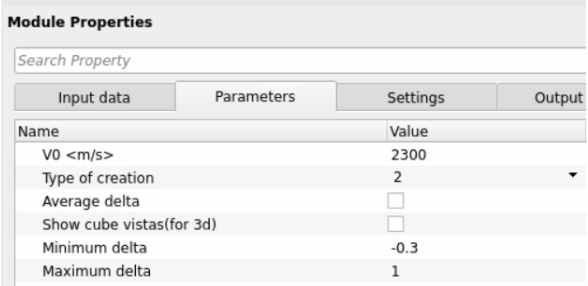
Click the Init velocities button in the action menu to load (initialize) velocities:
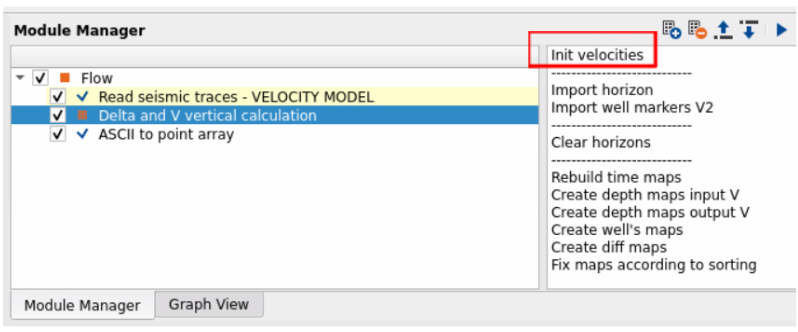
Vistas with velocities and map will then be updated, any Inline & Xline on the map can be selected (note that the area boundary polygon on the map is loaded using the ASCII to point array module, and its layer is added to the Location map):

Load horizons in time domain t0, which were picked by the seismic stack cube (in time):
First, in the module parameters we set the datum plane at which the horizon picking was performed, pay attention to the Scalar parameter - it is necessary in order to load a horizon for example from the time domain or the depth domain (if time, then the scalar is 0.001 ms, and if depth, then the scalar is 1)!!!! Change the scalar each time you load different horizons - for example first horizon in time and another time horizon in depth (for example, using your model horizon for tie, i.e. the horizon was prepared separately, e.g. by the interpreter, and we use this horizon for well-tie):

Set Marker type = TVDSS:

Define this group of parameters for gridding, i.e. map creation:
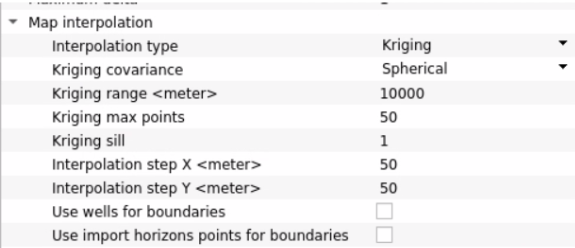
In the action menu click the Import horizon button:
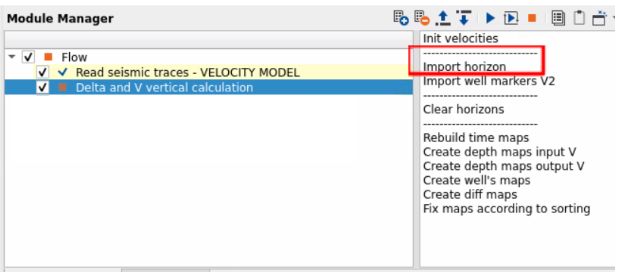
Note the format of the horizons: each horizon is written in a separate ASCII file and looks like this:
X coordinate, Y coordinate, time in ms:
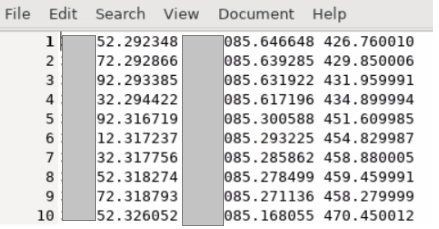
The columns are separated by a tab.
After loading, you can see the horizons in View properties Location map layers and select any one to display:
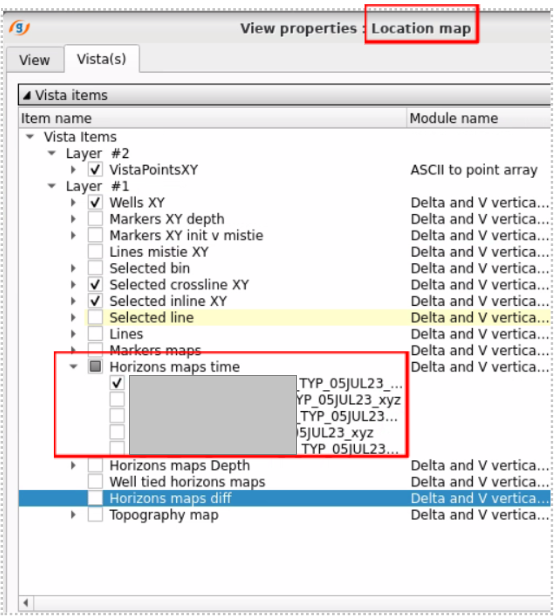
And the map of the selected horizon will be displayed in the Location map window.
Load horizon chops (TVDSS) from borehole data. File format: all chops are recorded in one ASCII file and have the following form:
Well name, horizon name, X coordinate, Y coordinate, depth in m, fake column with any value:
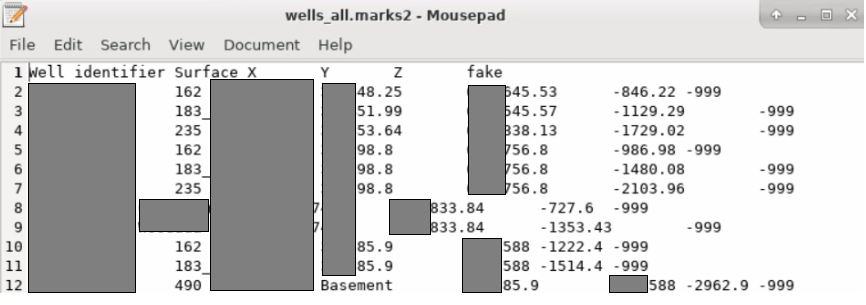
Press on Import well markers V2 in the Action menu:
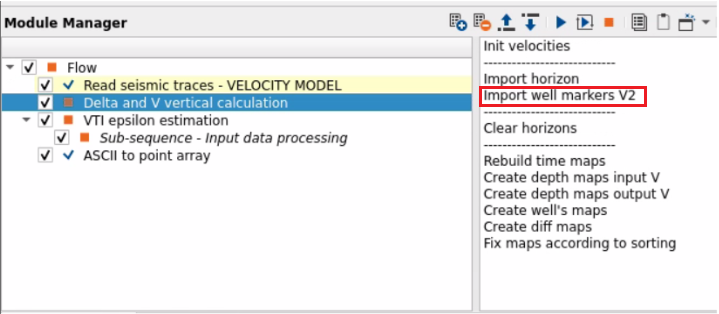
The markers are then available in the Well XY Location map layer:
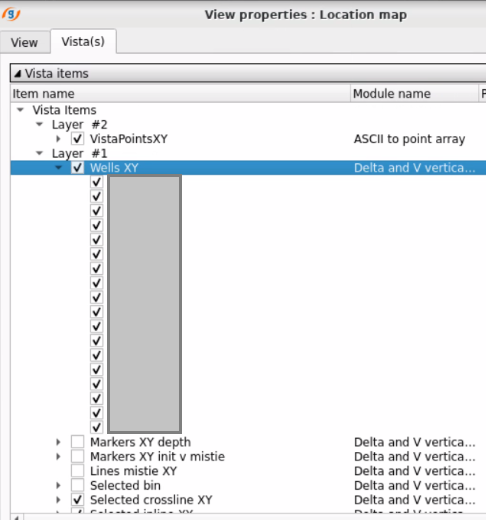
And the loaded wells will be displayed in the Location map window.
WELL-TIE: The Type of delta creation option = Constant delta
The Type of creation option = Constant delta from well tie params is when we want to enter a constant (average) delta value for each horizon used in the tie, so as not to distort the structural plan of the horizons. Therefore, we will not get the minimum tie values, but they will decrease with respect to the original tie values. This method was used on the project because of uncertainty in the correlation of the horizons, and uncertainty in the quality of the borehole bounces.
Parameters for constant delta:
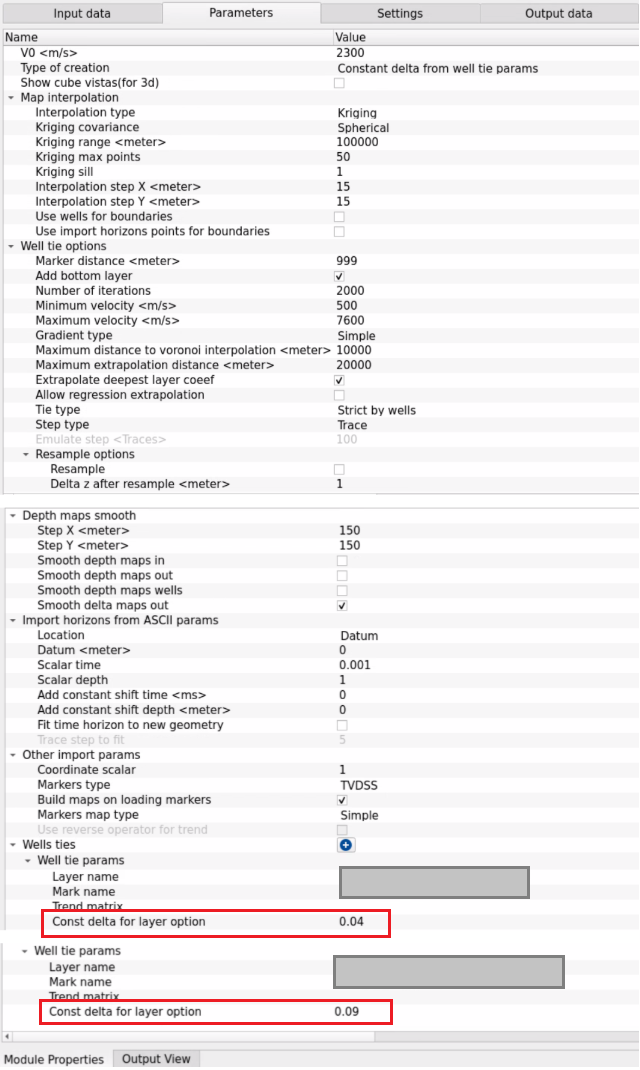
The value of Const delta for layer option is taken from the module's incoherence table, column Delta int before %, for the first horizon:
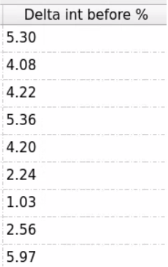
Here the average value is 4, so we specified 0.04 (4/100) in the parameters. Also for the second horizon, the value is 9, divided by 100, we get the parameter 0.09. Example of vertical delta cut for two horizons:

WELL-TIE: The Type of delta creation option = Well's map
The option of linkage method Type of creation = Well's map is when we want to perform linkage using the horizon map built on the basis of wells + trend on the input horizon or performing linkage on the loaded model horizon (e.g. prepared by the interpreter (verb Import well horizon)):
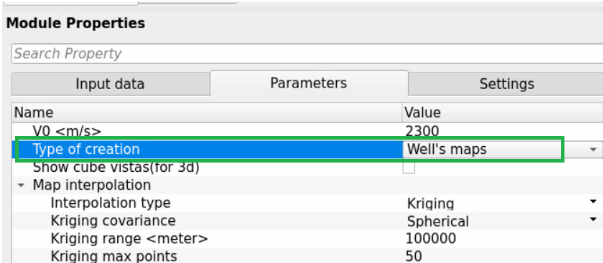
Final parameters for tie:


Calculated Delta vertical section with well tops:
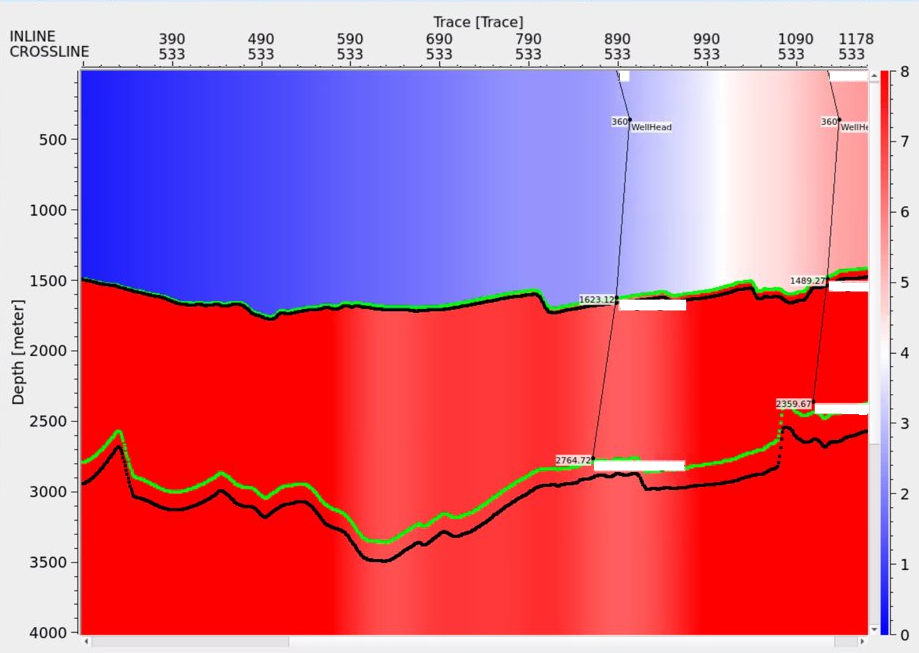
![]()
![]()
YouTube video lesson, click here to open [VIDEO IN PROCESS...]
![]()
![]()
 If you have any questions, please send an e-mail to: support@geomage.com
If you have any questions, please send an e-mail to: support@geomage.com